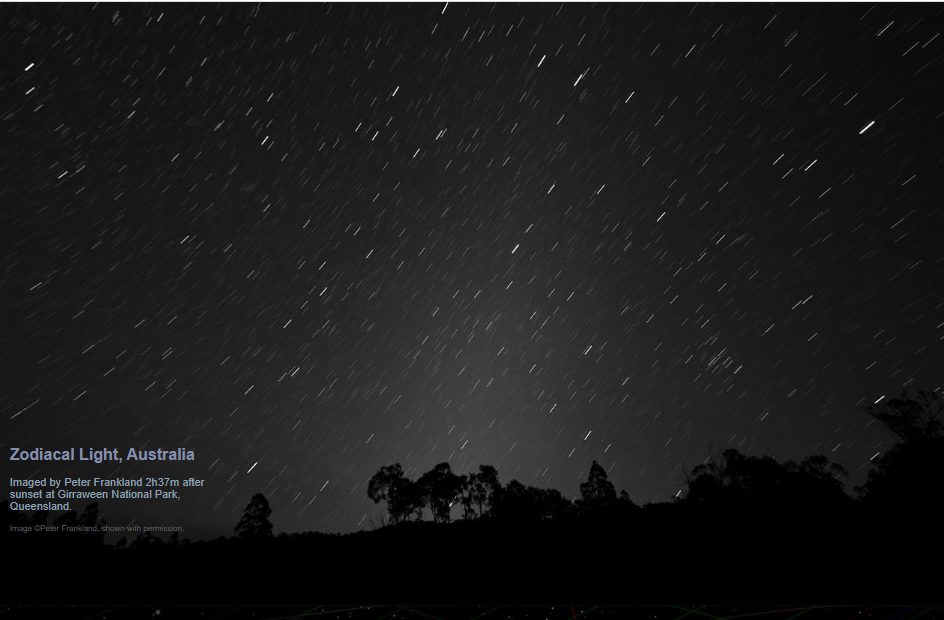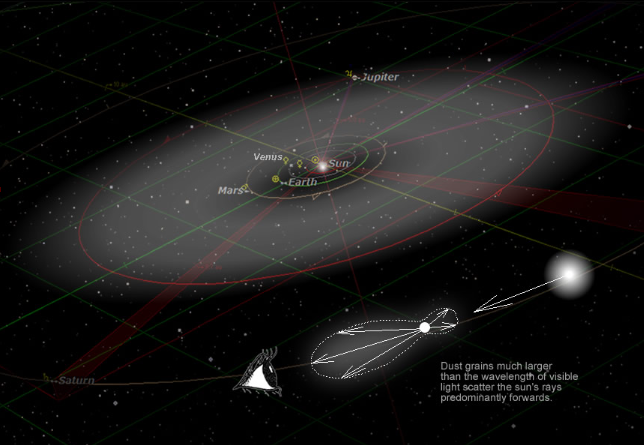OPOD -Zodiacal Light, Australia
OPOD - Zodiacal Light, Australia: A Breathtaking Celestial Phenomenon
Zodiacal Light is a mesmerizing natural spectacle that graces the skies of Australia. This ethereal phenomenon manifests as a delicate pearly cone of light, extending upwards from the direction of the sun and following the plane of Earth's orbit projected against the backdrop of stars - the ecliptic. While it may be challenging to spot, especially in light-polluted areas, the experience of witnessing this celestial phenomenon is truly awe-inspiring.
To catch a glimpse of the Zodiacal Light, one must venture out after sunset or before sunrise when the sky is enveloped in darkness. Unlike other celestial phenomena, the Zodiacal Light is faint and delicate, comparable in brightness to the majestic Milky Way. Therefore, it is essential to find a location with minimal light pollution to fully appreciate its beauty. Interestingly, it often becomes more apparent when observed using averted vision, where the observer looks slightly away from the object of interest. As one becomes attuned to its presence, the Zodiacal Light reveals itself, stretching across a larger expanse of sky than initially anticipated.
The visibility of the Zodiacal Light is influenced by various factors. The angle at which the ecliptic intersects with the local horizon plays a significant role. Lower latitudes offer better viewing opportunities for this celestial phenomenon. Additionally, the season also impacts visibility. In the Northern Hemisphere, where the ecliptic lies low along the horizon after sunset during certain periods, it may not be an ideal time to observe the Zodiacal Light. Conversely, in Australia's winter season, the ecliptic rises sharply from the horizon, providing optimal conditions for experiencing this captivating phenomenon.
The origin of the Zodiacal Light can be traced back to a disk of dust particles that extends beyond Jupiter's orbit and possibly even farther. These dust grains, ranging in size from 0.001 to 0.3 mm, likely originate from comets. Interestingly, these dust grains are relatively large compared to the wavelengths of visible light. As a result, they strongly scatter sunlight forwards, creating the radiant glow that characterizes the Zodiacal Light. Consequently, the intensity of the glow is most prominent in proximity to the sun.
Moreover, the Zodiacal Light is not limited to a single cone of light. A fainter Zodiacal Band encircles the sky, extending towards the gegenschein or counterglow, which is located directly opposite the sun. This additional feature adds an extra layer of mystique and grandeur to the already captivating spectacle of the Zodiacal Light.
In conclusion, witnessing the Zodiacal Light in Australia is an extraordinary experience that offers a glimpse into the enchanting wonders of our universe. As you gaze upon the soft pearly cone of light stretching across the sky, you become immersed in the beauty and vastness of the cosmos. So, if you find yourself in a location with minimal light pollution and during the appropriate season, take a moment to marvel at this celestial phenomenon that has captivated stargazers throughout history.

Zodiacal Light, Australia
Imaged by Peter Frankland 2h37m after sunset at Girraween National Park, Queensland.
Image ©Peter Frankland, shown with permission.

The Zodiacal light is a soft pearly cone of light extending upwards from the direction of the sun and along the plane of Earth's orbit projected against the stars - the ecliptic.
Search for it after sunset or before sunrise. The sky must be dark for the Zodiacal light is faint, perhaps the brightness of the Milky Way. Light polluted skies will not do. Averted vision often shows it first and then it becomes obvious to the eye. It covers a larger area of sky than expected.
Visibility strongly depends on the angle that the ecliptic makes with the local horizon. Low latitudes help. The season matters. Now is not a good time in the Northern Hemisphere because the ecliptic lies low along the horizon after sunset. In Australia it is winter and the ecliptic rises sharply from the horizon.
A disk of dust out to the orbit of Jupiter and perhaps beyond produces it. The dust grains are 0.001 to 0.3 mm across and likely originate from comets.
The dust grains are large compared to the wavelengths of visible light and consequently scatter sunlight strongly forwards. The glow is therefore brightest near to the sun.
A fainter Zodiacal Band extends around the sky to the gegenschein or counterglow directly opposite the sun.
Note: this article has been automatically converted from the old site and may not appear as intended. You can find the original article here.
Reference Atmospheric Optics
If you use any of the definitions, information, or data presented on Atmospheric Optics, please copy the link or reference below to properly credit us as the reference source. Thank you!
-
<a href="https://atoptics.co.uk/blog/opod-zodiacal-light-australia/">OPOD -Zodiacal Light, Australia</a>
-
"OPOD -Zodiacal Light, Australia". Atmospheric Optics. Accessed on November 26, 2024. https://atoptics.co.uk/blog/opod-zodiacal-light-australia/.
-
"OPOD -Zodiacal Light, Australia". Atmospheric Optics, https://atoptics.co.uk/blog/opod-zodiacal-light-australia/. Accessed 26 November, 2024
-
OPOD -Zodiacal Light, Australia. Atmospheric Optics. Retrieved from https://atoptics.co.uk/blog/opod-zodiacal-light-australia/.